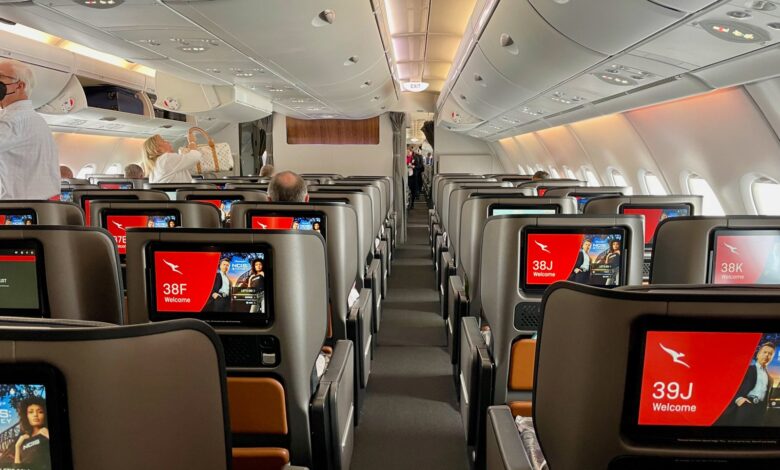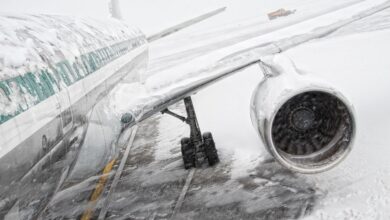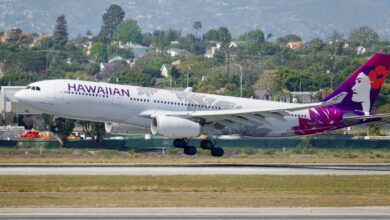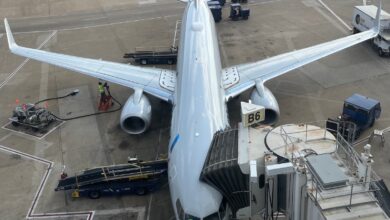Qantas A380 premium economy class flight review: Is it worth it?

Quick take: With friendly service, great food and a sleek cabin, premium economy on Qantas is a step up from economy — but the seat has one major design flaw.
Pros
- Delicious Australian-inspired dining options
- Genuinely friendly service
- Streamlined cabin and sharp seat finishes
Cons
- Limited legroom for most seats
- Subpar ground experience departing Melbourne
- No inflight Wi-Fi available
As an Australian living in the U.S. for the past decade, I try to fly an Australian airline in one direction and a U.S. carrier in the other for my annual visit Down Under.
In January, I flew Delta One Suites from Los Angeles International Airport (LAX) to Sydney Airport (SYD) and returned in Qantas’s A380 premium economy from Melbourne Airport (MEL) to Los Angeles.
Here is what the full experience was like flying Qantas premium economy aboard my favorite aircraft, the Airbus A380 superjumbo.
How much does premium economy cost to book on Qantas?
Qantas offers premium economy tickets on its Airbus A380 and Boeing 787 flights from:
- Dallas Fort Worth International Airport (DFW)
- Daniel K. Inouye International Airport (HNL)
- Los Angeles International Airport (LAX)
- John F. Kennedy International Airport (JFK) (via Auckland)
- San Francisco International Airport (SFO)
- Vancouver International Airport (YVR)
To:

Daily Newsletter
Reward your inbox with the TPG Daily newsletter
Join over 700,000 readers for breaking news, in-depth guides and exclusive deals from TPG’s experts
- Sydney Airport (SYD)
- Melbourne Airport (MEL)
- Brisbane Airport (BNE)
This cabin is not offered on the airline’s A330 flights from Los Angeles to Brisbane and Honolulu to Sydney (which switches seasonally between the 787 and A330).
The product is almost identical on the 787 and A380, except the 787 seat is one inch wider.
A tip: if you are connecting to another flight in Australia, Melbourne is the easiest of the three airports to connect; Brisbane is next and Sydney is the most stressful and time-consuming given the time and effort it takes to transfer between terminals.
Here is a sample of round-trip cash and award rates on Qantas flights from the U.S. mainland to Australia in the coming months:
| Class | Economy | Premium economy | Business class | First class |
|---|---|---|---|---|
| Airfare | From $950 | From $3,000 | From $7,000 | From $15,500 |
| American Airlines AAdvantage miles | From 80,000 miles plus $108 in taxes | From 130,000 miles plus $108 in taxes | From 160,000 miles plus $108 in taxes | From 220,000 miles plus $108 in taxes |
| Alaska Airlines Mileage Plan miles (for bookings made from March) | From 85,000 miles plus $108 | From 110,000 miles plus $108 | From 170,000 miles plus $108 | From 260,000 miles plus $108 |
| Qantas points | From 83,800 points plus $225 | From 162,600 points plus $332 | From 216,800 points plus $391 | From 325,600 points plus $391 |
As you can see, AAdvantage offers the most attractive redemption rates for most cabins (except for Alaska being cheaper for premium economy).
Versus Alaska Airlines Mileage Plan, which you can see below.
The taxes payable when you use Qantas points rather than American Airlines or Alaska miles more than double when flying economy and more than triple for premium cabins. For one-way redemptions, taxes are higher departing Australia rather than departing the U.S.
I used 81,300 Qantas points plus 292 Australian dollars ($190) for my one-way ticket from Melbourne to Los Angeles in January. I booked this ticket six months before departure.
Qantas releases award availability 353 days before departure and reserves a chunk of its premium cabin seats for its own elite members. By the time American Airlines’ and Alaska’s calendars open at 331 and 330 days, respectively, a lot of the premium award availability has already been snapped up.
Qantas then releases award seats in batches periodically (the timing is hard to predict) as well as sometimes in the week before departure — these are the best times to snag a ticket.
Related: How far in advance can you book a flight?
I used my Chase Sapphire Reserve to pay the taxes, earning 3 points per dollar spent. I could’ve used The Platinum Card® from American Express, which earns 5 Amex Membership Rewards points per dollar spent on flights booked directly with airlines or with American Express Travel, on up to $500,000 of these purchases per calendar year (then 1 point per dollar). However, the Chase Sapphire Reserve has better travel protections than the Amex Platinum.
Both cash fares and points-and-miles redemptions for Qantas premium economy include free seat selection, two checked bags up to 70 pounds each and two carry-ons up to 22 pounds each (must not exceed 30 pounds total).
Checking in to and boarding premium economy on Qantas
Qantas premium economy passengers do not receive many priority services at their departing airport:
| Lounge available | No |
|---|---|
| Fast Track access | No |
| Boarding group | After first- and business-class passengers and Oneworld Emerald and Sapphire elite-status members, before general economy |
When departing the U.S., you can also take advantage of TSA PreCheck if you’re a member.
At 48 hours before departure, Qantas opens up any blocked seats not taken by elite-status members or families traveling with infants in the cabin’s first row, meaning I could select one of the bulkhead seats.
Twenty-four hours before departure, I received an email and text from Qantas to check in online, which was easy. I received my boarding pass instantaneously and added it to my Apple Wallet.
Then, I arrived at the airport 90 minutes before departure to check my luggage.
Qantas international flights operate from Terminal 2 at Melbourne Airport, as do international flights operated by all carriers. The departures hall was under refurbishment at the time of my travel, which made for a cramped check-in area for all four cabins on an Airbus A380 departure to Los Angeles, not to mention an Airbus A330 flight to Singapore.
1 of 2
MATT MOFFITT/THE POINTS GUY
The Qantas employee checking tickets at the beginning of the premium economy line verified that I was indeed flying in the cabin. They then asked me a few security questions — as is customary for U.S.-bound flights — such as how long I’d been in Australia, where I lived in the U.S. and if I’d packed my own bag. After affixing a sticker to my passport, one of them directed me to a bag drop line for passengers who had already checked in online.
When I saw how long the line was — I estimated at least 30 people deep — I walked back and said I would rather go through the premium economy lane. It was illogical to me that someone who was diligent in checking in online to drop their self-tagged bags would be made to wait longer than someone who had just turned up to the airport to check into their flight. After a bit of to and fro, they allowed me into the premium economy line, which had no one waiting in it.
My frustration was amplified when I waited 10 minutes at the front of the line when the agents working the two premium economy counters invited four groups of economy-class passengers to check in before me. This did not indicate a premium experience. That said, the counter agent was friendly and efficient in checking my bags when it was finally my turn.
Security and immigration were a breeze. Premium economy passengers on most airlines don’t get lounge access (Japan Airlines is a notable exception). However, I stopped by the Centurion Lounge for a quick bite to eat, thanks to my Amex Platinum card.
Then came the most frustrating part of my travel experience: the boarding process.
Ahead of a 12:30 p.m. scheduled departure, the screens said the gate would open at 11:30 a.m. When I arrived, I encountered a cordoned-off area with third-party Menzies Aviation security personnel sitting down. There was no signage indicating to passengers that there would be a security check nor that they should wait, nor were there any announcements over the intercom.
Other passengers were visibly confused and some distressed at the lack of communication.
A long, snaking line through the middle of the airport walkway formed and 15 minutes later, the security personnel started their secondary security questioning of passengers. Then, cleared passengers were crammed into a small area that did not have enough seats for all passengers to sit down.
We were stuck in this area for another 30 minutes with no announcements over the intercom nor from the security personnel before passengers jostled with each other to head downstairs to the actual boarding area.
Eventually, I made my way onto the upper-deck jet bridge, where business and premium economy passengers board, and where there was another five-minute wait to actually step onto the plane.
The airport experience seemed to be an unnecessarily stressful hurry-up-then-wait experience and reflected poorly on the airline. We departed 40 minutes late but arrived on time to Los Angeles.
How comfortable was premium economy on Qantas?
The Qantas A380 premium economy cabin has 60 seats set up in a mostly 2-3-2 configuration at the back of the jet’s upper deck. The last two rows have fewer seats to accommodate a larger galley on the left-hand side of the plane.
The cabin on the 787 is less than half the size, with just 28 seats set up in a 2-3-2 configuration in four rows.
The cabin and seats are slick and aesthetically pleasing with black, metallic-gray, ochre-red and brown tones.
1 of 5
MATT MOFFITT/THE POINTS GUY
As mentioned earlier, I selected 31K, a bulkhead window seat. The cabin was only 30% full, so no one except those traveling with a companion had anyone sitting next to them, including me.
1 of 5
MATT MOFFITT/THE POINTS GUY
Here’s the basic layout of the cabin and seats:
| Cabin layout | 2-3-2 |
|---|---|
| Recline | 9 1/2 inches |
| Seat pitch | 38 inches for most seats; 42 inches for bulkhead seats |
| Seat width | 19 1/2 inches on the A380; 20 1/2 inches on the 787 |
| Screen size | 13.3 inches |
There are a few seats to avoid, especially those toward the back of the cabin.
| Best seats for couples | Any pair of A and B seats in rows 31-36* or J and K seats in rows 31-39
*Just be aware that if you are seated in 31B or 31J, the curtain separating the business and premium economy cabins may drape on your legs. |
|---|---|
| Seats to avoid | 37A, 37B, 39E, 39F, 40J and 40K due to limited recline and proximity to the lavatory
38D due to proximity to the lavatory |
My seat was directly behind one of the lavatories, so I was worried that passengers might gather in the aisle near me to wait to use the facilities. But it turns out there was a wall separating it from the premium economy cabin, so crowding wasn’t an issue.
On long-haul flights between the U.S. mainland and Australia, getting a reasonable amount of sleep is a major factor. Unfortunately, Qantas premium economy does not shine in this regard.
On my 14-hour flight, I was able to sleep on and off, but only for about six hours. Admittedly, there was a lot of turbulence. However, I found it difficult to get into a comfortable position to snooze. With the pillow attached to the headrest, there is very little head support to prevent your head from moving from side to side.
And while this aircraft has individual air nozzles, which I put on full blast before dozing off, I woke up sweating and realized that the cabin crew had shut off all of the air nozzles after our meal service when they dimmed the lights.
The major seat design flaw is that if you aren’t lucky enough to be in a bulkhead seat with no one in front of you (like I was) and the passenger in front of you reclines, you’ll feel cramped. If you’re in a window seat, leaving your seat to go to the restroom will be difficult without performing some calisthenics.
Contrast this to the most common and new A350-1000 offerings from Japan Airlines, which are shell-style seats that do not encroach on fellow passengers’ space.
Air New Zealand offers the most legroom if you’re flying to the South Pacific, with a generous seat pitch of 41 inches. American Airlines, Delta, Qantas and United Airlines all conform to the industry standard of 38 inches. Of the five airlines mentioned in this paragraph, Qantas does tend to offer the widest seats, though.
Despite the recent refurbishment of Qantas’s A380 fleet, the non-electric recline button means you’ll need to manually push your seat into recline mode — and use some force to pull it back up its upright position.
Most seats have an adjustable legrest with a kind of mesh net for your feet, which does provide some ergonomic relief.
1 of 2
MATT MOFFITT/THE POINTS GUY
Bulkhead seats have a different style of footrest, which folds up from the wall in front of you. I’m 5 feet, 11 inches, and could not stretch my legs out completely.
1 of 3
MATT MOFFITT/THE POINTS GUY
Moving onto storage, you’ll have limited options if you’re not in a window seat. The aisle and middle seats only have a small storage compartment attached to the seatback in front for a phone, charger or earplugs.
Window passengers get a ton of space with the storage bins next to the wall, which easily fit laptops, tablets, toiletries bags and books.
In the center console, there is a small groove to place earbuds.
Despite the A380 being the largest commercial aircraft in the sky, the overhead compartments are shallow, meaning full-size carry-ons need to be placed on their side rather than upright, contrary to the direction new aircraft are going.
Each seat has two USB-A charging ports, one in the armrest along with a headphone jack, and one in the entertainment screen. The columns between seats have a universal power plug, so you might have to share with a neighbor.
1 of 2
MATT MOFFITT/THE POINTS GUY
The 21-inch-wide fold-out table deploys manually from the armrest, and I found it sturdy when eating and watching shows on my iPad.
Each seat has a soft-yellow mood light, elevating the cabin’s ambience upon boarding. However, they shine quite brightly when the cabin lights are turned off.
Two dedicated lavatories for premium economy passengers are at the back of the cabin. They are both a standard size and do not offer any special amenities. Given my flight was quite empty, there was never a wait for the restroom.
Amenities in Qantas premium economy
Waiting at my seat was a long, rectangular pillow, a blanket, an amenity kit, basic noise-canceling headphones and a bottle of water.
The Qantas-branded noise-canceling headphones are mostly effective and are the quality I’d expect in premium economy; however, they’re the same ones given to business-class passengers, who often complain that they are flimsy.
The amenity kit is a welcome touch, with a Qantas-branded felt case and eye mask as well as cheap, thin socks, a miniature toothbrush and toothpaste, lip balm and earplugs.
The blanket is made of half-recycled material and is the thickest blanket I’ve encountered in the skies. I found it very comfortable, but as mentioned previously, I overheated when there wasn’t enough air circulating near me.
1 of 2
MATT MOFFITT/THE POINTS GUY
The seatback touchscreens are affixed to the seat in front of you and measure 13.3 inches diagonally, and have crisp resolution.
Bulkhead seats have slightly larger 14-inch touchscreens that fold out from the center console. Take care when touching these as they are always on (even when stowed away) and run very hot.
The Qantas inflight entertainment system is light on new releases but strong on classics, blockbusters from the past few years and superhero movies. There were only 13 movies in the Australia section. TV series are provided by a partnership with Paramount+ and HBO, featuring well-known hits like “Game of Thrones,” “The White Lotus” and “Fellow Travelers.”
There was no flight information or maps available on my flight, so I had no idea of our updated time of arrival or flight statistics.
While most Qantas domestic flights on Boeing 737 and Airbus A330 aircraft offer free, unlimited Wi-Fi to all passengers, international flights do not offer Wi-Fi. This is a serious disadvantage of flying Qantas, with American Airlines, Delta and United all offering Wi-Fi on their Australia flights.
How was the food in Qantas premium economy?
Waiting on the center console when I boarded was a one-page drinks menu with:
- Sparkling, white, red and dessert wines (although the sparkling wine was the only one that listed the actual product)
- Some fun aperitif options, including a bloody mary and Campari and soda
- A wide range of mid-tier spirits, including Absolut vodka and Beefeater gin
- Australian beers (again, these were unspecified)
- The standard nonalcoholic options of juice, coffee, tea and Coca-Cola soft drinks
The food menu was in the pouch at the front of my seat, so I did not find it until later.
1 of 3
MATT MOFFITT/THE POINTS GUY
I was warmly welcomed by one of the two cabin crew members staffing our cabin with the choice of water or sparkling wine. I chose the latter, which was Lane Lois Sparkling Blanc de Blancs NV from South Australia, which retails for about $16 per bottle.
I overheard another passenger asking for a ginger beer instead, and the cabin crew happily obliged, indicating their flexibility.
Thirty minutes after takeoff, I was served a generous portion of smoked almonds.
I also requested Qantas’s signature aperitif, the Sky Spritz, white wine and sparkling water infused with plum and finger lime botanicals. I could only get halfway through the 8-ounce can of the sweet beverage before moving on.
Forty minutes later, by which time I was quite ravenous, I was served my entire meal on a single tray.
The Greek salad starter was fresh, with crispy cucumbers and juicy tomatoes.
Passengers had the choice of three mains:
- Chicken salad with ancient grains, spinach and cherry tomatoes
- Wagyu beef with horseradish potato mash
- Risoni (also known as orzo) with mushroom sofrito
I chose the last option (the plant-based one), which was flavorsome but could have been bulked up with some more protein, such as lentils or chickpeas.
The real highlight of the meal was the perfect sourdough bread with a crunchy crust and spongy center.
The cheese was tangy but the crackers were unfortunately stale.
Finally, the cream cheese-topped carrot cake was deliciously moist and was followed by a Lindt chocolate ball.
After sleeping, I ordered an oat milk latte (which was a treat to be able to enjoy on a flight) and both midflight snacks. The reuben grilled cheese toastie was flavorful but a little soggy, and the spinach and filo pastry was crispy and delicious — and very salty, as I expected. (Did you know airplane food tends to have more sodium because up to 30% of your tastebuds are deactivated when you are in the air?)
On offer in the galley were self-serve snacks, including potato chips, dried fruit and nuts.
Finally, a prelanding, breakfast-style meal was served 90 minutes before our 7:50 a.m. touchdown in Los Angeles. There were two choices to accompany a banana and oat muffin:
- Hot breakfast: Spinach and feta omelet with bacon, sausage, baked beans and potatoes, and fruit salad
- Continental breakfast: Toasted muesli with strawberries and your choice of milk, and a fruit plate
I chose the latter, and it was unremarkable, but at least a light way to end the flight and nicely presented on the airline’s china.
The two cabin crew members who took care of our cabin could not have been more friendly and easygoing. They showed a genuine interest in each passenger, asking them the reason for travel and engaging with their answers.
I did have a somewhat brusque interaction with a stand-in cabin crew member whom I asked for midflight snacks as I walked back from the lavatory through the galley. I seemed to have caught them off guard with this request, as they were visibly annoyed and complained that they had just woken up from crew rest and had a lot to do. While it might have been best for me to return to my seat and press the attendant call button, it was unprofessional and off-putting to be treated dismissively. It was telling that the person who (promptly, I’ll say) served me the snacks at my seat was a different crew member.
As someone who likes to stay on top of their hydration game, especially on long-haul flights, I was disappointed that the crew ran out of water bottles three hours before landing, though they did refill my glass several times.
Would you recommend Qantas premium economy?
Qantas premium economy features an attractive cabin with delicious food and (mostly) cheerful service. However, the seat design can feel cramped, there is no Wi-Fi (which can be a blessing and a disadvantage), and the ground experience in Melbourne is disjointed.
On my annual visit to Australia, obviously, I prefer to fly on a lie-flat seat in business or first class to get a solid sleep and enjoy more space and privacy. However, premium-cabin award space to the South Pacific is not easy to come by and redemption costs can be high, so premium economy is a mostly worthwhile compromise.
Qantas has taken a battering from the Australian (and wider) public over the past few years due to public relations missteps, corporate issues and worker complaints. As much as it pains me to say this as an Australian, their onboard product has become less competitive, and their once-solid reputation as Australia’s flag carrier has deteriorated.
Qantas tends to charge slightly more than its competitors for premium economy cash fares from the U.S., and at this point, I don’t think it’s justified, so I would choose American Airlines, Delta or United instead.
If you have American Airlines AAdvantage miles, Alaska Airlines Mileage Plan miles or another Oneworld mileage currency, look into the option of flying American Airlines from Los Angeles to Sydney or Dallas Fort Worth to Brisbane (starting October with refreshed cabins).
Another option is to fly Fiji Airways with a free stopover in Nadi using Alaska miles, but they don’t have premium economy, so you’d need to use more miles for a business-class ticket.
Overall, I hopped off the plane at LAX with a dream and my cardigan … but also weary and ready to be off the flight. I won’t be rushing to fly Qantas premium economy again soon — especially because chances are I’d be cramped into a non-bulkhead seat with the passenger in front of me reclined for more than 13 hours. As it was, though, at least I had plenty of personal space, and could appreciate the Qantas touches like those amenity kits and the Aussie-sourced menus.
Related reading:




